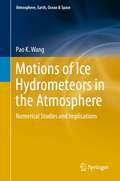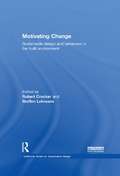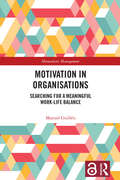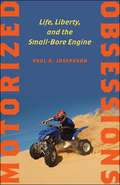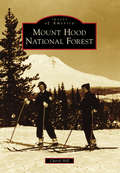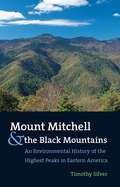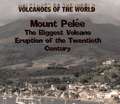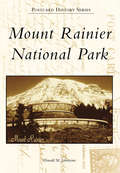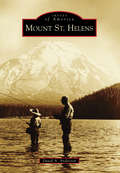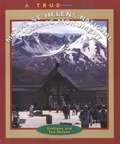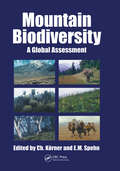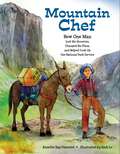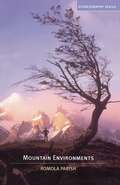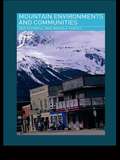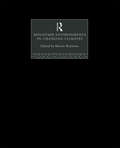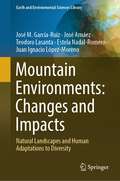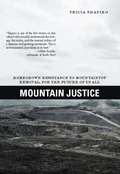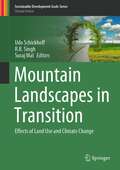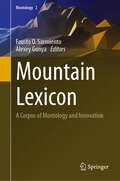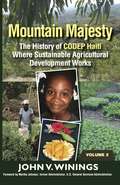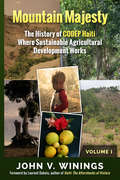- Table View
- List View
Motions of Ice Hydrometeors in the Atmosphere: Numerical Studies and Implications (Atmosphere, Earth, Ocean & Space)
by Pao K. WangThis book summarizes unique research findings on the hydrodynamic behavior of ice particles (ice crystals, snow, graupel and hailstones) in the atmosphere. The fall behavior of ice hydrometeors determines how and how fast a mixed-phase cloud can grow or dissipate. The book discusses how the authors used computational fluid dynamics (CFD) methods and numerical simulations to determine these behaviors, and presents these computations along with numerous detailed tables and illustrations of turbulent flow fields. It also examines the implications of the results for the general atmospheric sciences as well as for climate science (since the cloud problem is the source of the greatest uncertainty in model-based climate predictions). As such it allows readers to gain a clear and comprehensive understanding of how particles fall in clouds and offers insights into cloud physics and dynamics and their impact on the climate..
Motivating Change: Sustainable Design And Behaviour In The Built Environment
by Steffen Lehmann Robert CrockerToday’s most pressing challenges require behaviour change at many levels, from the city to the individual. This book focuses on the collective influences that can be seen to shape change. Exploring the underlying dimensions of behaviour change in terms of consumption, media, social innovation and urban systems, the essays in this book are from many disciplines, including architecture, urban design, industrial design and engineering, sociology, psychology, cultural studies, waste management and public policy. Aimed especially at designers and architects, Motivating Change explores the diversity of current approaches to change, and the multiple ways in which behaviour can be understood as an enactment of values and beliefs, standards and habitual practices in daily life, and more broadly in the urban environment.
Motivation in Organisations: Searching for a Meaningful Work-Life Balance (Humanistic Management)
by Manuel GuillenMotivation in Organisations: Searching for a Meaningful Work-Life Balance extends the current motivation models in business education to include motives of human behaviour that have been neglected for decades. It debunks some of the myths about human motivation (self-interest as the dominant factor, amorality and non-spirituality) and explains why this approach to teaching business is erroneous and leads to wrong and harmful practices in many organisations. In a very personal and engaging style, the author presents a "map of motivations", based on a humanistic approach to management. This includes the latest findings of Abraham H. Maslow supported by sound philosophical reflections and modern research. He also presents specific ways of putting the framework into practice, sharing stories from students and professionals of how this framework has helped them better understand their own motivations and look at their daily work in a much more meaningful way. The book is highly relevant to students and researchers in humanistic management, people management, organisational behaviour, business ethics, corporate social responsibility and sustainability. In short, this text will be truly inspiring to anyone who wants to reflect on motivations in organisations and how to achieve a better work-life balance.
Motorized Obsessions: Life, Liberty, and the Small-Bore Engine
by Paul R. Josephson2008 Outstanding Academic Title, Choice MagazineFrom dirt bikes and jet skis to weed wackers and snowblowers, machines powered by small gas engines have become a permanent—and loud—fixture in American culture. But fifty years of high-speed fun and pristine lawns have not come without cost.In the first comprehensive history of the small-bore engine and the technology it powers, Paul R. Josephson explores the political, environmental, and public health issues surrounding one of America's most dangerous pastimes. Each chapter tells the story of an ecosystem within the United States and the devices that wreak havoc on it—personal watercraft (PWCs) on inland lakes and rivers; all-terrain vehicles (ATVs) in deserts and forests; lawn mowers and leaf blowers in suburbia. In addition to environmental impacts, Josephson discusses the development and promotion of these technologies, the legal and regulatory efforts made to improve their safety and environmental soundness, and the role of owners' clubs in encouraging responsible operation.Synthesizing information from medical journals, recent environmental research, nongovernmental organizations, and manufacturers, Josephson's compelling history leads to one irrefutable conclusion: these machines cannot be operated without loss of life and loss of habitat.
Mount Baker
by John D'Onofrio Todd WargerMount Baker rises over northern Washington State like a mirage, dominating the landscape like few mountains in the United States. On a clear day, it is visible from as far away as Vancouver, British Columbia, and Tacoma, Washington. This immense volcano is a study in superlatives: it is the third-highest peak in the state, holds the world record for snowfall in a season (95 feet!), and is the second-most heavily glaciated peak in the contiguous United States. The mountain also played a dominant role in the history of the region, having served as a beacon to seafarers and a lure for men in search of gold, timber, and adventure.
Mount Hood National Forest
by Cheryl HillThe Mount Hood National Forest is the closest national forest to Portland and encompasses the northern end of Oregon's Cascade Mountains and the Columbia River Gorge. Established in 1908 as the Oregon National Forest and renamed the Mount Hood National Forest in 1924, it now consists of more than a million acres. The forest is home to Oregon's tallest mountain, as well as eight designated wilderness areas covering more than 300,000 acres. The forest is also the site of the historic Timberline Lodge and old Barlow Road, the final leg of the Oregon Trail. Thousands of visitors come to the forest every year for camping, hiking, mountain climbing, fishing, skiing, mountain biking, and other recreational pursuits.
Mount Mitchell and the Black Mountains
by Timothy SilverEach year, thousands of tourists visit Mount Mitchell, the most prominent feature of North Carolina's Black Mountain range and the highest peak in the eastern United States. From Native Americans and early explorers to land speculators and conservationists, people have long been drawn to this rugged region. Timothy Silver explores the long and complicated history of the Black Mountains, drawing on both the historical record and his experience as a backpacker and fly fisherman. He chronicles the geological and environmental forces that created this intriguing landscape, then traces its history of environmental change and human intervention from the days of Indian-European contact to today. Among the many tales Silver recounts is that of Elisha Mitchell, the renowned geologist and University of North Carolina professor for whom Mount Mitchell is named, who fell to his death there in 1857. But nature's stories--of forest fires, chestnut blight, competition among plants and animals, insect invasions, and, most recently, airborne toxins and acid rain--are also part of Silver's narrative, making it the first history of the Appalachians in which the natural world gets equal time with human history. It is only by understanding the dynamic between these two forces, Silver says, that we can begin to protect the Black Mountains for future generations.
Mount Pelee: The Biggest Volcano Eruption of the 20th Century
by Kathy FurgangThis 1902 eruption occurred on the Caribbean island of Martinique. Only two of the 30,000 residents of the town of St. Pierre survived this blast. It was the first eruption that gave scientists a chance to observe the damage shortly after the event.
Mount Rainier National Park (Postcard History)
by Donald M. JohnstoneMount Rainier rises 14,410 feet above sea level and can be seen on any given day by over three million people and from over 100 miles away. It is America's fifth national park, established in 1899. The mountain is an active but currently dormant volcano. With 25 named glaciers, 50 smaller unnamed glaciers, and numerous perennial snowfields, Mount Rainier boasts the largest glacier system in the continental United States. In addition to the glacier zone, the park has alpine and subalpine forest and subtropical rain forest. Each zone has its own unique ecology of plants and animals. The vistas of and from the mountain are some of the most spectacular in all of the park system.
Mount St. Helens
by David A. AndersonThe story of Mount St. Helens is that of an active volcano and human interaction with it. The mountain is culturally important to the regional native people. Its Cowlitz name, Lawetlat'la, means "Person From Whom Smoke Comes." Early European settlers saw opportunities to make a living from the natural resources, and people fell in love with the forested valleys and slopes of the glacier-clad peak with the blue lake at its foot. Forgotten were the eruptions of the 19th century and the fact that the landscape was a product of frequent violent explosions. A report from the 1970s reminded locals that Mount St. Helens is an active volcano and could erupt again before the end of the 20th century. Only a few people at that time were aware of what the mountain was capable of, and many were surprised at the events that took place in 1980.
Mount St. Helens National Volcanic Monument (True Books-National Parks)
by Sharlene Nelson Ted NelsonNIMAC-sourced textbook <P><P>Describes the destruction caused by the eruption of Mount St. Helens in 1980. <P><P>Lexile Measure: 820L
Mountain Biodiversity: A Global Assessment
by Ch. Körner E. M. SpehnThis book is the result of the first global conference on mountain biodiversity, and is a contribution to the International Year of Mountains, 2002. The Global Mountain Biodiversity Assessment program is a Special Target Area Region project of DIVERSITAS (UNESCO and UNEP). Biological diversity is essential for the integrity of mountain ecosystems and this dependency is likely to increase as environmental (climate) and social conditions change. Steep terrain and climate, and severe land-use pressure cause mountain ecosystems to rank among the world's most endangered landscapes. The 28 chapters in this book represent research on the biological riches in all major mountain ranges of the world, and synthesize existing knowledge on mountain biodiversity - from diversity of bacteria, plants and animals to human diversity. The book is divided into five sections: an introduction providing an overview of the issues; plant and animal diversity; climate change and mountain biodiversity; land use and conservation; and a synthesis.
Mountain Biodiversity: A Global Assessment (Routledge Library Editions: Ecology #7)
by Ch. Körner E. M. SpehnOriginally published in 2002, Mountain Biodiversity deals with the biological richness, function and change of mountain environments. The book was birthed from the first global conference on mountain biodiversity and was a contribution to the International Year of Mountains in 2002. The book examines biological diversity as essential for the integrity of mountain ecosystems and argues that this dependency is likely to increase as environmental climates and social conditions change. This book seeks to examine the biological riches of all major mountain ranges, from around the world and using existing knowledge on mountain biodiversity, examines a broad range of research in diversity, including that of plants, animals, human and bacterial diversity. The book also examines climate change and mountain biodiversity as well as land use and conservation.
Mountain Chef: How One Man Lost His Groceries, Changed His Plans, and Helped Cook Up the National Park Service
by Annette Bay PimentelThe true story of a Chinese American mountain man who fed thirty people for ten days in the wilderness--and helped inspire the creation of the National Park Service. Tie Sing was born in the mountains. The mountains were in his blood. But because he was of Chinese descent at a time in America when to be Chinese meant working in restaurants or laundries, Tie Sing&’s prospects were limited. But he had bigger plans. He began cooking for mapmakers and soon built a reputation as the best trail cook in California. When millionaire Stephen Mather began his quest to create a national park service in 1915, he invited a group of influential men—writers, tycoons, members of Congress, and even a movie star—to go camping in the Sierras. Tie Sing was hired to cook. Tie Sing planned diligently. He understood the importance of this trip. But when disaster struck—twice!—and Tie Sing&’s supplies were lost, it was his creative spirit and quick mind that saved the day. His sumptuous menus had to be struck and Tie Sing had to start over in order to feed the thirty people in the group for ten whole days. His skills were tested and Tie Sing rose to the challenge. On the last night, he fed not just the campers' bodies, but also their minds, reminding them to remember and protect the mountains. 2016 marks the 100th anniversary of the National Park Service, created by Congress on August 25, 1916. Today, you can hike to Sing Peak, named for Tie Sing, in Yosemite National Park.
Mountain Environments (Ecogeography Series)
by Romola ParishThis book breaks the ground in Geographical texts by transcending a strictly regional or topical focus. It presents the opportunities and constraints that mountains and their resources offer to local and global populations; the impacts of environmental and economic change, development and globalisation on mountain environments. Part of the Ecogeography series edited by Richard Hugget
Mountain Environments and Communities (Routledge Physical Environment Ser.)
by Romola Parish Don FunnellMountain Environments and Communities explains the background physical environment and then explores the environmental and social dimensions of mountain regions.This critical review of the concepts currently employed in mountain research, draws upon a wide range of examples from developed and developing countries. The dynamics of mountain life are described through both historical accounts of village-based systems and examples of the contemporary impact of global capital and sustainable development strategies.
Mountain Environments in Changing Climates
by Martin BenistonHome to large numbers of people, sources of water, centres of tourism, and sensitive ecological zones, mountain environments share distinctive climactic characteristics. Once regarded as economically non-viable regions, mountains now attract major investment as sites of tourism, hydro-power and communication routes. This book brings together some of the current work on the physical and human ecology of mountain environments, the impacts of climate change, the processes involved and their observation and prediction.
Mountain Environments: Natural Landscapes and Human Adaptations to Diversity (Earth and Environmental Sciences Library)
by José M. García-Ruiz José Arnáez Teodoro Lasanta Estela Nadal-Romero Juan Ignacio López- MorenoThis book studies mountains with a global perspective, like a complex topographic and topoclimatic mosaic organized in altitudinal belts that are influenced by a huge variability in slopes, soils, lithology and insolation. Furthermore, the presence of lower temperatures, higher precipitation and the seasonal presence of snow create conditions conductive to supporting various life forms and natural geomorphological and hydrological processes. The integration of environmental and human aspects highlights the impacts of human activities and climate fluctuations on soil hydrology, soil erosion, water resources, and landscape/landforms evolution. After presenting the way in which humans (from Prehistory to Alexander von Humboldt) discovered the mountains, subsequent chapters try to underline the importance of mountains in generating water resources and hydropower for lowlands, serving as biodiversity hotspots, and contributing to cultural diversity. The book delves into the role ofhuman actives in transforming the natural landscapes and creating new cultural landscapes. This exploration considers the significance of altitudinal belts in shaping the spatial and temporal organization of land uses which, in turn, have been determined by population growth and the development of regional and national markets. Additionally, the book illustrates the effect of global change on mountain evolution, exploring their consequences on landscape characteristics and dynamics as well as on the planetary role of the mountains. It concludes by offering a unique perspective on enhancing mountain conservation in order to preserve cultures, land uses, and landscapes.
Mountain Geography
by Alton Byers Martin Price Larry W. Price Donald Friend Thomas KohlerMountains cover a quarter of the Earth's land surface and a quarter of the global population lives in or adjacent to these areas. The global importance of mountains is recognized particularly because they provide critical resources, such as water, food and wood; contain high levels of biological and cultural diversity; and are often places for tourism and recreation and/or of sacred significance. This major revision of Larry Price's book Mountains and Man (1981) is both timely and highly appropriate. The past three decades have been a period of remarkable progress in our understanding of mountains from an academic point of view. Of even greater importance is that society at large now realizes that mountains and the people who reside in them are not isolated from the mainstream of world affairs, but are vital if we are to achieve an environmentally sustainable future. Mountain Geography is a comprehensive resource that gives readers an in-depth understanding of the geographical processes occurring in the world's mountains and the overall impact of these regions on culture and society as a whole. The volume begins with an introduction to how mountains are defined, followed by a comprehensive treatment of their physical geography: origins, climatology, snow and ice, landforms and geomorphic processes, soils, vegetation, and wildlife. The concluding chapters provide an introduction to the human geography of mountains: attitudes toward mountains, people living in mountain regions and their livelihoods and interactions within dynamic environments, the diverse types of mountain agriculture, and the challenges of sustainable mountain development.
Mountain Geography
by Larry W. Price Thomas Kohler Alton C. Byers Martin F. Price Donald A. FriendMountains cover a quarter of the Earth's land surface and a quarter of the global population lives in or adjacent to these areas. The global importance of mountains is recognized particularly because they provide critical resources, such as water, food and wood; contain high levels of biological and cultural diversity; and are often places for tourism and recreation and/or of sacred significance. This major revision of Larry Price's book Mountains and Man (1981) is both timely and highly appropriate. The past three decades have been a period of remarkable progress in our understanding of mountains from an academic point of view. Of even greater importance is that society at large now realizes that mountains and the people who reside in them are not isolated from the mainstream of world affairs, but are vital if we are to achieve an environmentally sustainable future. Mountain Geography is a comprehensive resource that gives readers an in-depth understanding of the geographical processes occurring in the world's mountains and the overall impact of these regions on culture and society as a whole. The volume begins with an introduction to how mountains are defined, followed by a comprehensive treatment of their physical geography: origins, climatology, snow and ice, landforms and geomorphic processes, soils, vegetation, and wildlife. The concluding chapters provide an introduction to the human geography of mountains: attitudes toward mountains, people living in mountain regions and their livelihoods and interactions within dynamic environments, the diverse types of mountain agriculture, and the challenges of sustainable mountain development.
Mountain Justice
by Tricia Shapiro"Shapiro is one of the few writers on this subject that actually understands the strategy, the tactics, and the internal politics of a dynamic and growing movement. This is environmental journalism at it best."-Mike Roselle, Earth First! founder and author of Tree SpikerMountaintop removal (MTR) does exactly what it says: a mountaintop is stripped of trees, blown to bits with explosives, then pushed aside by giant equipment-all to expose a layer of coal to be mined. Hundreds of thousands of acres of ancient forested mountains have been "removed" this way and will never again support the biologically rich and diverse forest and stream communities that evolved there over millions of years-all to support our flawed national energy policy.Mountain Justice tells a terrific set of firsthand stories about living with MTR and offers on-the-scene-and behind-the-scenes-reporting of what people are doing to try to stop it. Tricia Shapiro lets the victims of mountaintop removal and their allies tell their own stories, allowing moments of quiet dignity and righteous indignation to share center stage. Includes coverage of the sharp escalation of anti-MTR civil disobedience, with more than 130 arrests in West Virginia alone during the first year of the Obama administration.Tricia Shapiro has been closely following and writing about efforts to end large-scale strip mining for coal in Appalachia since 2004. She now lives on a remote mountain homestead in western North Carolina, near the Tennessee border.
Mountain Landscapes in Transition: Effects of Land Use and Climate Change (Sustainable Development Goals Series)
by R. B. Singh Udo Schickhoff Suraj MalThis book compiles available knowledge of the response of mountain ecosystems to recent climate and land use change and intends to bridge the gap between science, policy and the community concerned. The chapters present key concepts, major drivers and key processes of mountain response, providing transdisciplinary orientation to mountain studies incorporating experiences of academics, community leaders and policy-makers from developed and less developed countries. The book chapters are arranged in two sections. The first section concerns the response processes of mountain environments to climate change. This section addresses climate change itself (past, current and future changes of temperature and precipitation) and its impacts on the cryosphere, hydrosphere, biosphere, and human-environment systems. The second section focuses on the response processes of mountain environments to land use/land cover change. The case studies address effects of changing agriculture and pastoralism, forest/water resources management and urbanization processes, landscape management, and biodiversity conservation. The book is designed as an interdisciplinary publication which critically evaluates developments in mountains of the world with contributions from both social and natural sciences.
Mountain Lexicon: A Corpus of Montology and Innovation (Montology #2)
by Fausto O. Sarmiento Alexey GunyaThis book is the second volume in a series on montology dedicated to the transdisciplinary reflection of mountain research, considering the diversity of views on mountains and their problemata in the context of rapid technological development and unprecedented accumulation and dissemination of information around the world. The necessity for a new orderly and structured lexicon arose from the need to critically reassess the colonial past in the development of mountain territories, the development of a new and alternative understanding of mountain topics in the light of decolonized epistemology. The creation of coordinated and ordered terms for the main parts of mountain research creates the basis for an unorthodox understanding of the ontology of mountains and helps to better understand the complex cultural and natural essence of mountain socio-ecological systems. At the same time, a local episteme of mountains, considering local values, small scales, and vernacular visions are of particular importance, which must be taken into account in the current terminology. The purpose of the book is to provide methodological support for montology as a convergent and transdisciplinary science of mountains, based on the harmonization of its terminological base. The book pays special attention to onomastics, toponymy, standardization and other nuances of terms used in mountain research. According to this goal, three dozen articles in a relatively small format (about 3 pages) vividly, attractively and innovatively reflect the modern view of one or more related terms. Articles include definition(s) of the term, description of etymology, onomastics or toponymy used, examples of local characteristics compared to traditional sources, possible vernacular terms. Articles are grouped into four main areas: 1) Basic glossary of montology terminology, 2) Towards mountain socio-ecological systems, 3) Innovative disciplinary systemic realm, 4) Mountain classifications, onomastics, critical toponomy and rediscovery of meaning. The authors of the articles are leading experts in the field of mountain research from around the world. The book is intended for scientists, experts and teachers. It is provided with an annotated list of the most important montology terms.
Mountain Majesty: A History Of Codep Haiti Where Sustainable Agricultural Development Works Vol. 2
by John V WiningsWhat makes...an organization successful? A leader effective? A community thrive? Especially in impoverished, disaster-prone Haiti? Mountain Majesty: The History of CODEP Haiti Where Sustainable Agricultural Development Works, Volume 2 reveals the inner workings and complexities of this remarkable organization as it grew into today’s highly successful, locally-managed Haitian NGO. Professionals and academics will find a vital case study in organizational leadership. Casual readers will enjoy cultural insights and personal stories that illustrate how CODEP caused hope to grow on trees in rural Haiti.
Mountain Majesty: The History of CODEP Haiti Where Sustainable Agricultural Development Works (Vol 1)
by John V WiningsMountain Majesty: The History of CODEP Haiti Where Sustainable Agricultural Development Works takes an in-depth look at a unique organization that has improved the lives of thousands of rural Haitians through sustainable agricultural development. Together, Jack and Evelyn Hanna embarked on their dream retirement. They outfitted a boat to cruise the Caribbean islands and planned to do volunteer work where they could. But a chance encounter with a desperate Barbadian woman challenged their assumptions and ultimately changed the course of countless lives.
